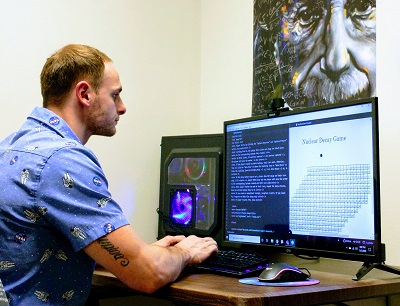Physics: Fun and Games
 CMU physics professor Dr. Matthew Redshaw and undergraduate student Dakota Keblbeck collaborate on the development of a nuclear physics game called “Chart of the Isotopes”. The game aims to help teach middle school and high school students about nuclear physics and astrophysics. Dr. Redshaw’s research involves measuring the mass of atoms. Based on Albert Einstein’s famous equation E = mc2, mass and energy are equivalent. Finding the mass tells physicists what energy is required to bind atoms together. This is important for testing the law of physics and understanding nuclear reactions in stars.
CMU physics professor Dr. Matthew Redshaw and undergraduate student Dakota Keblbeck collaborate on the development of a nuclear physics game called “Chart of the Isotopes”. The game aims to help teach middle school and high school students about nuclear physics and astrophysics. Dr. Redshaw’s research involves measuring the mass of atoms. Based on Albert Einstein’s famous equation E = mc2, mass and energy are equivalent. Finding the mass tells physicists what energy is required to bind atoms together. This is important for testing the law of physics and understanding nuclear reactions in stars.
Under the guidance of Dr. Redshaw, junior physics student Dakota leads the project. The game was inspired by a podcast on NPR (National Public Radio) about biology boardgames. Dr. Redshaw wanted to create his own game that would help teach students about nuclear physics and astrophysics. With the help of his computer science instructor, Dakota has begun developing the game. “Chart of the Isotopes” is a web-based game where players start as hydrogen atoms then change to heavier elements by undergoing nuclear reactions, similar to what happens in stars and supernova explosions. Dr. Redshaw and Dakota designed the game to show how the elements we find on Earth are created. Players navigate the game by learning about how matter created in the Big Bang evolves through nuclear reactions in stars.
“Chart of the Isotopes” is aimed to teach students about physics in an engaging way. The physics department here at CMU covers a lot of bases, from performing fundamental research in labs, to bringing physics to the community. Dr. Redshaw and Dakota hope to attract the next generation of physics students by showing them how fun and fascinating it can be!
At CMU We Do Research, We Do Real World
Story by ORGS intern Hailey Nelson
January 2021